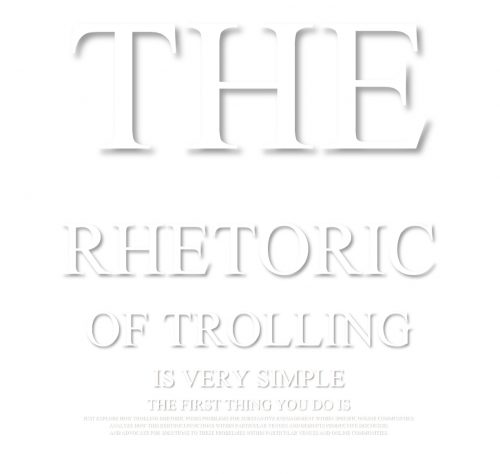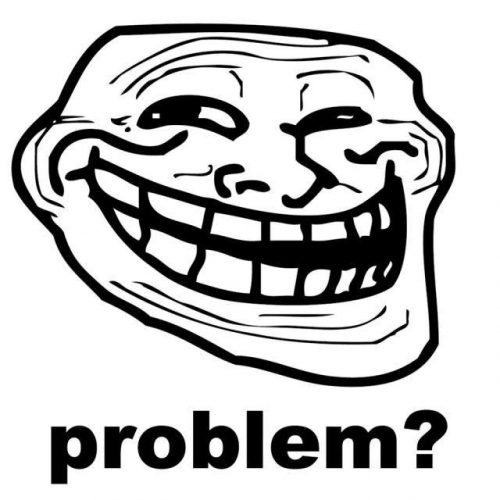Matt Breece, a graduate student in Rhetoric, has been teaching the Rhetoric of Trolling for two semesters, accidentally becoming a trolling expert. I talked to him about his course, which he is teaching this semester in one of our DWRL classrooms.
–Interview transcription–
Sarah Welsh: Hi Matt
Matthew Breece: Hi Sarah
S: So what are you doing in the rhetoric of trolling?
M: First off I should say that I’m not teaching my students how to be trolls. As a rhetoric class, and a writing class, first and foremost we analyze and write about arguments. So we start off thinking about anonymity and real names in specific online venues. But also analyzing comments sections and looking at trolling strategies and their responses and seeing how it works for a community and how it’s productive and what it generates.

S: Why did you decide to design this class? What inspired you?
M: I was looking for a way to teach analysis that’s not just Aristotelian, in the normal you know, logos, pathos, ethos sense, and I was inspired by Trish Roberts Miller’s work on demagoguery. Designing this class I wanted to think about kind of transferring that over and still keeping it public, but looking at online discourse. Initially at least, it looked like there would be some parallels between her work in demagoguery that would translate–although I found [demagoguery and trolling] are different–I ended up finding some interesting ways in which trolls use certain kinds of strategies to accomplish their goals.
S: What kinds of strategies? Can you name one or two?
M: Well, things like false sincerity. Also with trolling, one of the things is about baiting, it’s about trying to get other people to respond. There are also ways in which they provoke futile argument. Some of the maybe, argument fallacies of attacking a straw person, calling arguments rumors, things that may provoke others in the community to respond.
S: What are some of your students’ impressions of what trolling is? What have they found?
M: So, we just finished our analysis paper, and what they told me is they found that trolling is far more common than they suspected, once they actually started digging around. They also discovered that it takes many different forms. It’s kind of funny: they noticed that trolls troll other trolls. They also hadn’t thought about–and discovered through our lenses–that trolls use actual strategies to get responses. And they also noticed that trolling is a lot more complex than just flaming and insults. But I will admit that some of them found that people just spend way too much time on the internet and waste their time.
[Laughs]
S: What are you hoping that your students will take away from this class at the end of the semester?
M: Well, first and foremost it’s a writing class so I want them to think about their writing and practice their writing throughout the semester. But secondly, kind of a critical analysis to see things in a new and different light. Also, digital and public literacy combined – especially because trolling happens in online public spaces. And also think about their own ethical engagement within those spaces.
S: So this is your first time teaching in one of our DWRL classrooms, so every student could have a computer if they wanted one, it’s a networked classroom. How has that experience been or how has it been different from teaching in a regular classroom?
M: Especially for this class, the advantage – I’ve taught this in a non-digital classroom over the summer and the difference is huge. Not only does it give us a chance to do some of our work together, but the opportunities for collaboration especially something like this: one of our assignments- preparing for it -is really looking through comments sections, looking for strategies and doing that work when they can pair up and work together is really beneficial. Because some students have a lot of experience with comments sections and the myth of the “digital native” doesn’t really apply to everyone. So that’s one aspect of it. But it also just helps with their ability to do research and share sources, and also we have a discussion board where they can contribute different tools that they use to help improve their writing and their writing process along with fun or interesting articles that they find about trolling.
S: If anyone is interested in researching this, where would be a good place to start?
M: There’s an older New York Times article from 2008 called “The Trolls among Us” by Mattathias Schwartz. I think that’s when it first started becoming public and people starting taking recognition. There’s a nice book by Whitney Phillips called “This is Why We Can’t Have Nice Things,” she kind of compares offline and online culture and comes to the conclusion that perhaps they’re not quite so different – it’s been a cultural shift. But as far as academic research, as a way in, Susan Herring and colleagues’ article “Searching for Safety Online: Managing Trolling in a Feminist Forum,” is a nice article that talks about different strategies and kind of walks us through.

S: Cool. Anything else you want to add?
M: Yeah…one thing to think about throughout this was it really matters how you define trolling, especially if you’re going to analyze it. We stuck to a conservative definition of it being disingenuous communication meant to bait or upset others, or it being deliberate uses of deception and manipulation to create a context conducive to triggering and antagonizing conflict. So, basically how does trolling disrupt conversation in comments sections?
Within this it’s kind of interesting thinking perhaps about the origins of the world “trolling” – less meaningful perhaps is the image of the troll under the bridge trying to grab someone, but more of the fishing metaphor of trying to bait and see who latches on. And so, when we analyze trolling, it becomes really interesting because first we look at strategies and try to figure out who the troll is, but also how these strategies are trying to bait and control certain types of people. So we can see who’s politically left or right, often sexist or racist, and how these strategies are trying to provoke certain types of people. But even more interesting than looking in comments sections is our ability to look at user responses and seeing if it worked or what happened as a result of these strategies. And it doesn’t always happen in typical ways: sometimes it might not necessarily be a productive conversation, but it will generate a lot more writing afterwards. So the responses can take a lot of different forms. So, just as a text that looks at digital rhetorics, it offers a lot of ways to look at digital writing.
S: When you’re analyzing a comments section, that’s something that I would think of as changing pretty quickly, are you looking at newer articles or, how are you doing that?
Often I would recommend looking at something somewhat static, from nothing too distant but something like two years old or a year old, because that’s always a problem, people delete things, people get deleted. And that’s important because these are living communities and it’s a text that gets altered all the time.
S: If someone in a rhetoric classroom wanted to do just one little trolling exercise in a classroom – explore a comments section in a short lesson, what could they do?
M: We spent a day and kind of dove right in, just looking at a list of strategies and the way they work. And when you go through a comments section it’s really a place where you have to go do a little bit of research and dig around a bit. But my advice usually is to look for threads that have a lot of responses. Really long threads. Comments sections where people are responding to one another- response really becomes a part of it. But in a class if you have an hour and 15 minutes, just introducing some of the strategies, and even something easy like Susan Herring’s article to pull out those four major strategies and look around in a comments section and see what your students find. I would recommend doing it in a collaborative way so they can talk about it and they aren’t lone wolfing – they can and can discuss it. It’s a bit confusing and hard to tell for all sorts of reasons – anonymity, In written text it’s hard to read things like sarcasm and intention. It’s difficult. So students being able to talk about that is really important.


